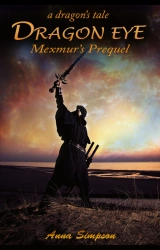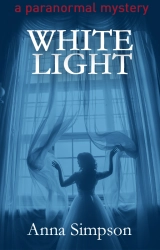From the beginning I’ve read that said/asked were invisible. It never occurred to me to worry about it when tagging dialogue. But some editors do care if they read said/asked a dozen times in a row. Who’d of thunk it?
I recently got back my manuscript of White Light and guess what. My line editor didn’t like all the says/asks and suggested that I get rid of most of them. The rule  seemed to be one of either per page (250 words.)
seemed to be one of either per page (250 words.)
Reinforcing the rules:
- Use specific + active verb to express exactly what you mean
- Avoid being repetitive—phases and words
- Remove all unnecessary words
It took a bit of work, but here’s how I did it.
Example:
“Thanks,”.” I say, my voice let out a breath full of relief.
Example:
“Oh, you are a rogue.” Mrs. Perkins blushes batting her eyes as they release hands.
“That’s me. Lock up your virgins,”.” he says.
I wait for it and Mrs. Perkins doesn’t disappoint.
“Well, I guess Emma isn’t in any danger then.” She giggles, intending her comment to be funny.
It wasn’t.
 a list I found on line and a few ideas of my own.
a list I found on line and a few ideas of my own.Example:
Cane lady, Jay, sayspipes up, “I’ll call then. You’re still using Alice’s number, aren’t you?”
So that’s it. My three solutions to repetitive dialogue tags. Hope it helps you as much as it helped me.
What do you do to keep it clean?
Gleaned from:










Good post! I always like to use action instead of dialogue tags or else eliminate the tags altogether.
This is something I must master. 🙂
One of the things I have been trying to learn is the deep showing and deep POV, which also eliminates some of those tags, because the reader can see it in the picture you paint with words with auto flows from character to character eliminating the constant tagging to show who is talking. This example probably will not be very good, but…
—
Sam opened the cabinet door gently his hand just inches from the Little Debbie’s cake. “Sam Guthrie, get out of that cabinet right now. You know better!” His heart slammed his chest. The step chair wobbled. Wide-eyed, he glanced over his shoulder to meet his mother’s angry stare.
—
I am learning this from reading Description: Elements of Fiction by Monica Woods book from the Elements of Fiction writing series. I love this book. It is about description, but is also of the best in teaching deep showing and somewhat deep POV.
Repetitive words is one I need to work on too. It is the little words e.g. too many and’s or like and such. You never realize how much you use little words repetitively, until you start trying to take them out. Phrases too.
Thanks, I’ll have to check it out 🙂
This is such a good post, Anna. I’m often surprised how many people add ‘says’ when it’s clear who’s talking. Get the word out there that they needn’t do this!
Thanks, Jacqui. I’m one of the worst offenders 🙂
I never have a problem with using dialogue tags other than said/asked — as long as I don’t go overboard with crazy ones that draw attention away from the story. But as you point out above, there are many times you just don’t need one at all.
As for “said” being invisible, that might be true. But as a former teacher who used to read books aloud to the class, “said” became glaringly obvious when repeated out loud, over and over!
My editor’s point, I believe. 🙂
Great examples! I try to eliminate dialogue tags too by adding in some more physical responses. It always does the trick.
I must learn this. I must. “\o/”
Great post. I try not to overuse “said” by using different variations of it like “screeched” or “begged,” in its place. Or drop it and use action between the dialogue.
Watch out for being redundant and I’m sure it will be fine. Or at least, that’s my plan. 🙂
Fantastic post Anna. I love the way it flows when you take out the unnecessary pointers.
Thanks, Kim. Very writer’s goal in a nutshell. 🙂
I do my best to clean up the dialogue tags too. Get some action or insight in there. Great post! 🙂
Thanks. It’s a challenge sometimes not to have talking heads. 🙂
Great post! I’d always heard that “said” was invisible, too. I try not to use it much, though. Replacing it with an action, like you did in your example, works so much better. And if it’s obvious who’s talking, leave it out.
Well now, we both stand corrected. hehehe
That definitely makes for more active/engaging dialog. Excessive tags drive me crazy, especially when reading out loud.
Well that’s another vote for changing my ways. Thanks, Crystal. 🙂
I’m back again for another look at your excellent WP site. I always find posts worth reading. Tips are very helpful 🙂
Thanks. Glad to see you again. 🙂
I think as long as I know who’s talking, I don’t care, but your suggestion for action is a great idea and adds a lot to the sentence.
sherry @ fundinmental
I think that was part of what my editor was getting at. Adding some spice, or depth is always a good thing. 🙂
I’ve gotten to the point where I rarely use dialogue tags and try to stick with actions to keep the story moving as well as to denote who’s speaking. Of course, the occasional said, asked, and whispered are useful. I think the key is not to be too repetitive because repetition becomes very noticeable.
So true. 🙂
I am so bad at the unnecessary words. I use them all the time them have a lot of deleting to do.
You are not alone. hehehe
Dialogue tags are like dust on the chandeliers: you never realize how much they’ve built up until you go to clean them out!
Nicely put. 🙂